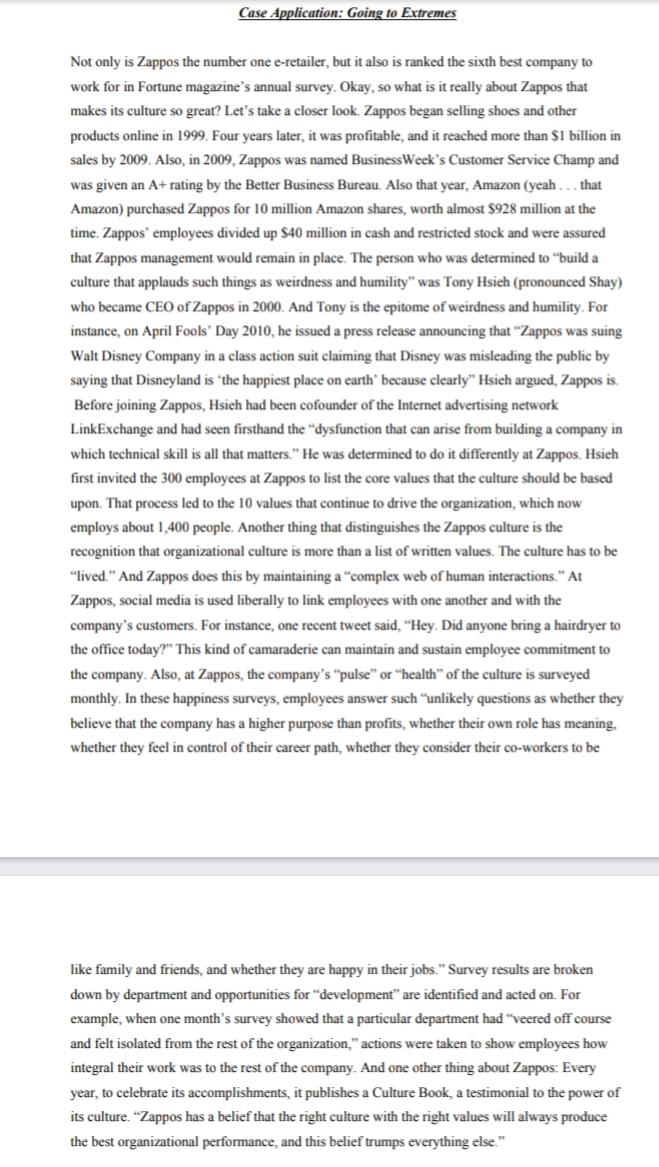3. How did Zappos' corporate culture begin? How is Zar intain
Management, Loose-Leaf Version
13th Edition
ISBN:9781305969308
Author:Richard L. Daft
Publisher:Richard L. Daft
Chapter3: The Environment And Corporate Culture
Section: Chapter Questions
Problem 1ED
Related questions
Question

Transcribed Image Text:3. How did Zappos' corporate culture begin?
How ir Zapnor
naintainad"

Transcribed Image Text:Case Application: Going to Extremes
Not only is Zappos the number one e-retailer, but it also is ranked the sixth best company to
work for in Fortune magazine's annual survey. Okay, so what is it really about Zappos that
makes its culture so great? Let's take a closer look. Zappos began selling shoes and other
products online in 1999. Four years later, it was profitable, and it reached more than $1 billion in
sales by 2009. Also, in 2009, Zappos was named BusinessWeek's Customer Service Champ and
was given an A+ rating by the Better Business Bureau. Also that year, Amazon (yeah . . that
Amazon) purchased Zappos for 10 million Amazon shares, worth almost $928 million at the
time. Zappos' employees divided up S40 million in cash and restricted stock and were assured
that Zappos management would remain in place. The person who was determined to “build a
culture that applauds such things as weirdness and humility" was Tony Hsieh (pronounced Shay)
who became CEO of Zappos in 2000. And Tony is the epitome of weirdness and humility. For
instance, on April Fools’ Day 2010, he issued a press release announcing that “Zappos was suing
Walt Disney Company in a class action suit claiming that Disney was misleading the public by
saying that Disneyland is 'the happiest place on earth' because clearly" Hsieh argued, Zappos is.
Before joining Zappos, Hsieh had been cofounder of the Internet advertising network
LinkExchange and had seen firsthand the “dysfunction that can arise from building a company in
which technical skill is all that matters." He was determined to do it differently at Zappos. Hsieh
first invited the 300 employees at Zappos to list the core values that the culture should be based
upon. That process led to the 10 values that continue to drive the organization, which now
employs about 1,400 people. Another thing that distinguishes the Zappos culture is the
recognition that organizational culture is more than a list of written values. The culture has to be
"lived." And Zappos does this by maintaining a “complex web of human interactions." At
Zappos, social media is used liberally to link employees with one another and with the
company's customers. For instance, one recent tweet said, “Hey. Did anyone bring a hairdryer to
the office today?" This kind of camaraderie can maintain and sustain employee commitment to
the company. Also, at Zappos, the company's “pulse" or “health" of the culture is surveyed
monthly. In these happiness surveys, employees answer such “unlikely questions as whether they
believe that the company has a higher purpose than profits, whether their own role has meaning,
whether they feel in control of their career path, whether they consider their co-workers to be
like family and friends, and whether they are happy in their jobs." Survey results are broken
down by department and opportunities for “development" are identified and acted on. For
example, when one month's survey showed that a particular department had “veered off course
and felt isolated from the rest of the organization," actions were taken to show employees how
integral their work was to the rest of the company. And one other thing about Zappos: Every
year, to celebrate its accomplishments, it publishes a Culture Book, a testimonial to the power of
its culture. "Zappos has a belief that the right culture with the right values will always produce
the best organizational performance, and this belief trumps everything else."
Expert Solution
This question has been solved!
Explore an expertly crafted, step-by-step solution for a thorough understanding of key concepts.
Step by step
Solved in 5 steps

Knowledge Booster
Learn more about
Need a deep-dive on the concept behind this application? Look no further. Learn more about this topic, operations-management and related others by exploring similar questions and additional content below.Recommended textbooks for you

Management, Loose-Leaf Version
Management
ISBN:
9781305969308
Author:
Richard L. Daft
Publisher:
South-Western College Pub


Management, Loose-Leaf Version
Management
ISBN:
9781305969308
Author:
Richard L. Daft
Publisher:
South-Western College Pub
